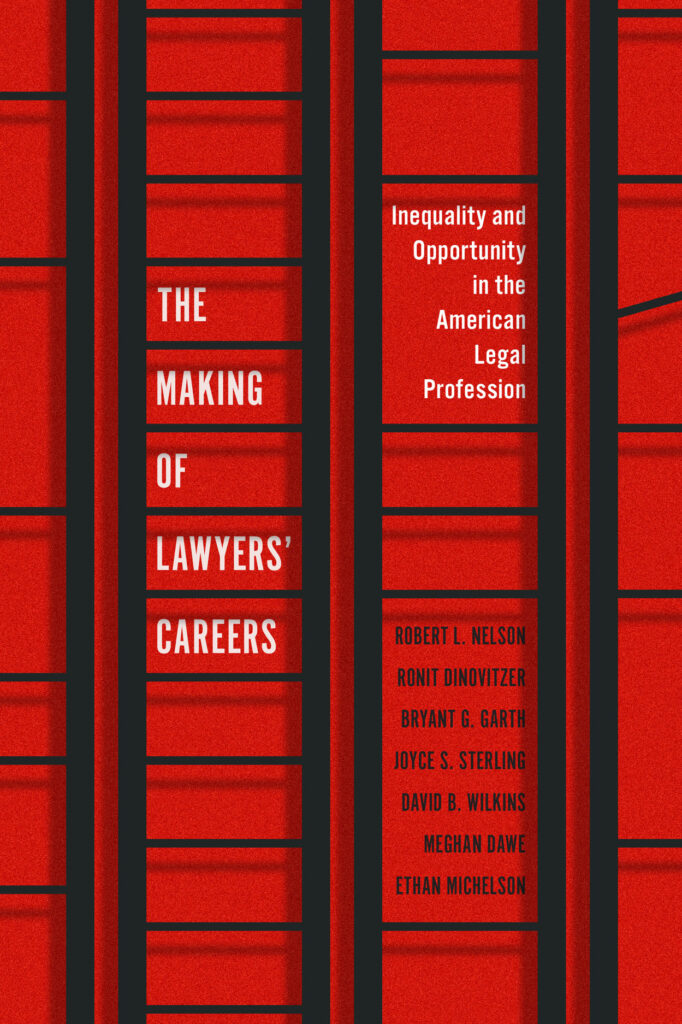The American Bar Foundation (ABF) has long been recognized as the leading source of research on legal education and the profession. Among these projects is the first longitudinal study of legal careers in the U.S., After the JD, which tracked the professional lives of more than 4,500 lawyers after passing the bar in 2000. After twenty years of study, the project researchers have published their capstone book project, The Making of Lawyers’ Careers: Inequality and Opportunity in the American Legal Profession, authored by Robert L. Nelson, Ronit Dinovitzer, Bryant G. Garth, Joyce S. Sterling, David B. Wilkins, Meghan Dawe, Ethan Michelson.

The Making of Lawyers’ Careers offers a data-backed look at the structure of the profession and the inequalities that early-career lawyers face across race, gender, and class distinctions. Researchers collected over 10,000 survey responses from a nationally representative cohort of 5,000 lawyers and conducted over 200 in-depth interviews, drawing insights from individual stories. Their findings conclude that despite systemic inequality and career segmentation in the legal profession, career satisfaction among lawyers of all backgrounds and identities remains high.
“Many years of work went into following this cohort of lawyers as their careers unfolded, and the results provided unprecedented insight into America’s evolving legal profession,” said ABF Executive Director Mark Suchman. “This book is a deep dive into young (and by now not-so-young) lawyers’ struggles and triumphs over the past two decades, as they’ve sought to build meaningful and rewarding careers despite obstacles, challenges, and reversals, both personal and structural. This is the kind of sustained, engaged project that makes the most of ABF’s unique interdisciplinary research environment.”
From the thousands of careers researchers tracked during this study, researchers were able to distill these into typical career pathways. The most important determinant of one’s career path is where the lawyer went to law school. More than half of graduates from highly-ranked law schools started at large law firms, and another 13% work in midsize firms. In contrast, graduates of tier 3 and tier 4 law schools are far more likely to start as solo or small-firm attorneys, in state government, or business.
Further, the structure of career advancement is still affected by racial discrimination. White and African American lawyers have similar chances of making equity partner through the first six years of their careers. However, later in their careers, white lawyers are much more likely to make this advancement, while African American lawyers are more likely to leave their law firms, ended up in positions in government and the nonprofit sector.
The Making of Lawyers’ Careers also finds a gendered wage gap in all stages of lawyers’ careers, even in the first few years after law school, suggesting that the mechanisms underlying earning inequalities cannot be entirely explained by women leaving the workforce to transition into parenthood. Researchers also found a ‘fatherhood bonus’, meaning that men with children out-earn – by a large margin – childless men, childless women, and women with children. Women with no children, in all workplace settings and backgrounds, earn the least. Mothers only earn more than non-mothers when they exhibit the traits of the fathers in their practice, matching their work hours, leadership, and breadwinner status.
“It is apparent that women have been integrated within the legal profession in a way that both accommodated its need for growth while allowing the old status hierarchies to continue to operate, rewarding women to comply with prevailing norms,” said contributing author Ronit Dinovitzer.
Despite all these challenges, The Making of Lawyers’ Careers finds that 78% of the cohort reported being moderately or extremely satisfied with their decision to become a lawyer. They especially appreciated autonomy in small or solo practices, social contributions in government and public interest, and money and prestige in large law firms.
“I hope this book encourages legal leaders to recognize that the simplistic explanations for the lack of diversity in the legal profession – such as minorities leave for government roles and women leave for family reasons – are inadequate,” said ABF Affiliated Research Professor and contributing author Bryant Garth. “They should understand that the current structure of the legal profession inhibits genuine inclusivity. I also hope law students read this and realize they’re not alone in facing obstacles to inclusion. This awareness should embolden them to seek solutions and allies, refusing to accept ‘no’ as an answer.”
For more information on this study, view the videos below:
###
About the American Bar Foundation
The American Bar Foundation (ABF) is the world’s leading research institute for the empirical and interdisciplinary study of law. The ABF seeks to expand knowledge and advance justice through innovative, interdisciplinary, and rigorous empirical research on law, legal processes, and legal institutions. To further this mission the ABF will produce timely, cutting-edge research of the highest quality to inform and guide the legal profession, the academy, and society in the United States and internationally. The ABF’s primary funding is provided by the American Bar Endowment and the Fellows of The American Bar Foundation.
